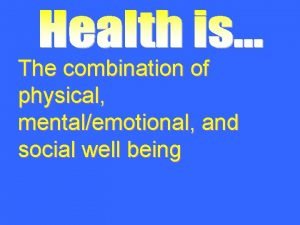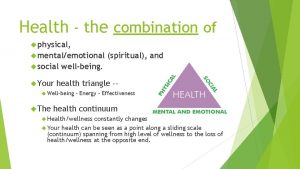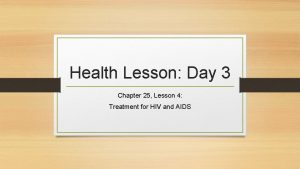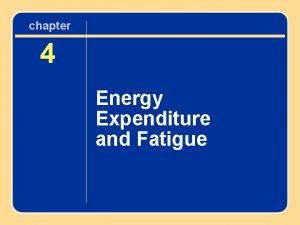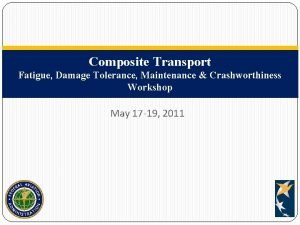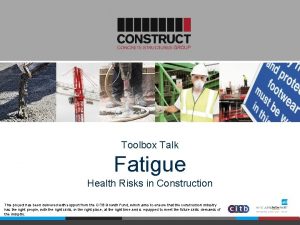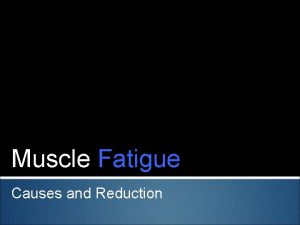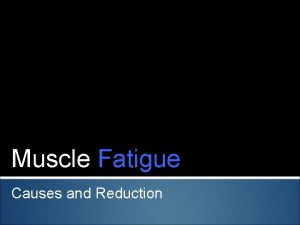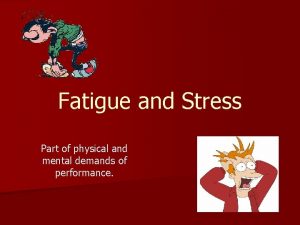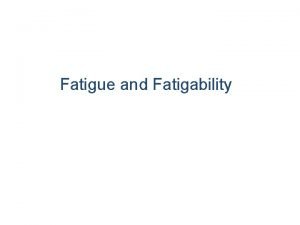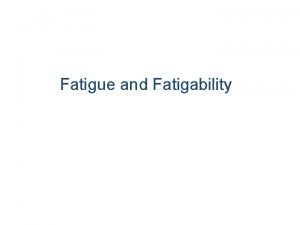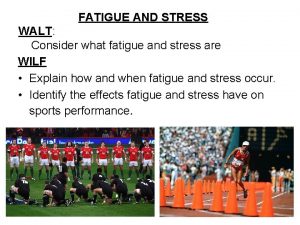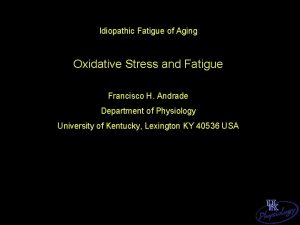Fatigue FATIGUE Physical and or Mental lethargy or

















- Slides: 17

Fatigue FATIGUE: Physical and or Mental lethargy or exhaustion triggered by stress, exercise, overwork, illness or disease RECOVERY: Is the overcoming or reversal of the fatigue experienced as the result of participation in a training session or some for of exercise bout, where body systems repair damaged tissue and replenish energy stores

Fatigue During exercise, skeletal muscles cannot maintain constant levels of contraction. With repeated contractions, there is a loss of force as fatigue sets in Fatigue: exercise-induced reduction in the power generating capacity of muscle and inability to continue the activity Fatigue sees a reduction in both muscle force and shortening velocity; together, these bring about reduced muscular power as well

TYPES OF FATIGUE Central Occurs when muscular function is decreased as a result of Central Nervous System (CNS) impairment Peripheral Occurs when muscle function is disrupted at the muscle site(s) as a result of impaired internal muscle processes

LEVELS OF FATIGUE Local General Chronic Localised to a muscle or group of muscles. Occurs when a group of muscles is called upon repeatedly during training or performance Tends to occur after completing a full training session or competitive game. Feelings of weak muscles and psychological fatigue Unhealthy breakdown of their immune system. Caused by overtraining, inappropriate recovery strategies and excessive competition demands Commonly felt after competing weights or biceps/triceps after a game of squash Commonly experienced after completing a circuit session or a full game of hockey Commonly diagnosed as chronic fatigue syndrome (CFS) or sometimes Glandular Fever

Factors affecting Fatigue Ø Exercise duration Ø Exercise intensity Ø Type of activity (intermittent or continuous) Ø Types of muscular contractions (isotonic, isometric, isokinetic) Ø Physical fitness Ø Conditioning Ø Age Ø Diet Ø Environmental conditions Ø Nutritional state Ø Elevated body temperature Ø Muscle fibre type (fast or slow twitch)

The most effective type of recovery for the athlete will be determined by the particular causes of fatigue. If athletes do not allow their bodies to adequately recover from activity, especially repeated bouts of activity, the effects of the fatigue will accumulate.

Peripheral Fatigue Mechanisms of peripheral muscular fatigue Fuel Depletion ATP Accumulation of metabolic byproducts Impaired muscle excitability Glycogen PC H+ Pi ADP

Fuel depletion • Depletion of ATP and then PC are the most common causes of fatigue • Enough ATP stored in muscles to complete 1 -2 secs of activity • Enough stored PC to complete around 10 secs of activity • Muscle glycogen stores are limited and deplete relatively quickly (can be in as little as 40 mins for intense prolonged exercise / 90 – 120 mins for submaximal activity) • Exercise intensities above 65 – 85% of VO 2 max fatigue is closely correlated with depletion of muscle glycogen stores • Repeated sprint efforts can lead to the depletion of glycogen in fast twitch fibres. Lower exercise intensities will still be possible, but intense bouts will be affected since fibres capable of producing the muscular force is necessary • Fats become the predominate substrate, therefore exercise pace must slow down. • The sensation of fatigue during prolonged exercise seems to coincide with a decreased concentration of muscle glycogen.

Metabolic by-products H+ in plasma & muscles: The breakdown of glucose or glycogen produces lactate and H+. For each lactate molecule, one H+ is formed. The presence of H+ makes the muscles acidic, decreasing muscle function. The acidic environment will slow down enzyme activity and ultimately the breakdown of glucose itself Normal p. H levels are around 7. 1 at rest. p. H less than 6. 9 = increased acidity = decreased rate of glycolysis & disrupts the muscle contractile processes. Interferes with the role of Calcium in the tole of actin-myosin coupling. Pi & ADP: The accumulation of Pi & ADP that occurs rapidly may have something to do with the role of calcium in the contractile processes and cross bridge coupling.

LACTIC ACID Lactic acid is continuously being produced and removed. Lactate production increases in proportion to our exercise rates and a workload will be reached which sees lactate accumulation (known as LIP) LIP: the exercise intensity beyond which lactate production exceeds removal (sometimes referred to as lactate threshold). Triggered above 85% of max HR. Glucose molecules are split into 2 pyruvic acid molecules, releasing energy to form ATP. With sufficient oxygen, the pyruvic acid enters the mitochondria to produce more ATP. Without sufficient oxygen the pyruvic acid transforms into lactic acid. Glycolysis results in the formation of pyruvic acid and H+. H+ make muscle cells acidic and interfere with their operation NAD+ carries H+. NAD+ removes the H+ NAD+ is broken down to NADH depositing the H+ at the electron transport gate in the mitochondria to be combined with oxygen to form water. If there is insufficient oxygen available then NADH cannot release the H+ and they build up in the cell

To reduce the rise in acidity, pyruvic acid combines with H+ to form lactic acid, which then breaks down to lactate and H+. Some lactate diffuses into the bloodstream and takes some H+ with it as a way of reducing the H+ concentration in the muscle cell. QUESTIONS: • How does the depletion of PC stores contribute to local muscular fatigue? • How long after the beginning of sustained aerobic activity will glycogen stores typically become depleted? • When glycogen stores become depleted, what usually happens to the intensity at which the athlete is able to continue exercising? Explain why the change occurs. • Explain the phenomenon referred to in athletic circles as ‘hitting the wall’? • Explain the ways in which the accumulation of H+ is thought to be implicated in muscular fatigue.

Lactic acid and lactate are 2 different substances. Lactic acid is produced during glycolysis but quickly breaks down and releases H+. The remaining compound combines with either sodium or potassium ions to form a salt known as lactate.

QUESTION TIME Pi is released within the ATP-PC energy system and from the breakdown of stored ATP. Physiologists have hypothesised that the accumulation of Pi is probably the largest contributor to the fatigue process in exercise of any duration. How does Pi contribute to fatigue? Clearly indicate what the LIP refers to. Other than accumulation of H+, identify 2 factors that could contribute to an 800 m runner experiencing fatigue during this event. Outline how lactate can be beneficial to performance. Researchers have discovered that fatigue mechanisms are probably ‘multifactorial’. What does this mean? When lactic acid is broken down, 65% is converted into CO 2 and water, 20% into glycogen, 10% into protein and 5% into blood glucose. a. Apart from as a fuel source, how can the converted protein assist recovery? b. Why is blood glucose more valuable than glycogen when lactic acid is oxidised?

Neuromuscular factors Decreased CNS ‘firing’: • When the brain detects fatigue • Weaker signals are sent to the working muscles to reduce intensity and slow down the work rate of muscles. • As fatigue occurs, there is less electrical stimulation crossing to the muscle, meaning muscles will contract less forcefully • The brain regulates exercise in regard to a neurally calculated safe exertion level for the body (central govenor) • Impairs the processes involved in ‘muscle excitation-contraction coupling’ – the term used to describe the physiological processes of converting an electrical stimulus to a mechanical response.

Elevated body temperature Normal core body temp ranges from 36. 5 to 37. 5 degrees celsius Increased muscle temp enhances the ability of the muscles to contract (warm-up) During maximal exercise (90 mins or more) up to 90% of body heat can be generated by exercising muscle, with the remaining heat coming from external air conditions (temp & humidity) Heat loss – during exercise, sweat is produced to provide body cooling. In warm environments, evaporation is the main mechanism for heat loss. Thermoregulation – The ability to keep body temp within certain boundaries even when the surrounding temp is very different. Losing 2 -3% of body weight through sweating results in impaired thermoregulation, muscle endurance and neuromuscular co-ordination. If more than 6% of body weight is lost via sweating, may result in unconsciousness to protect the body from over heating.

Body temp rises more than 3 degrees can result in impairment of bodily and mental functions. As core temp increases, sweat increases and blood is distributed away from working muscles to the skins surface to maximise cooling. Hypothermia – can result from exercising in extreme cold. When hypothermia develops, the body initially directs its attention to reducing heat loss and generates heat through shivering Results in a decrease in blood flow to the extremities If body temp continues to fall, the body begins to shut down both physically and mentally. COMPLETE CHAPTER REVIEW QUESTIONS 1, 2, 3 a, 4, 6 a&b and 10

Dehydration 3 types of dehydration: Hypertonic – Loss of water Hypotonic – Loss of electrolytes Isotonic – Loss of water and electrolytes Increase in body temp leads to sweating which leads to a reduction in blood plasma volume = less blood available The body loses its ability to thermoregulate due to decreased plasma 2% decrease in body weight = decreased performance by 20% 3 -5% decrease = decreased reaction time, concentration, impaired decision making 15% decrease = usually end in a fatality Athletes can acclimatise to an environment
 Chapter 20 mental health and mental illness
Chapter 20 mental health and mental illness Stress management jeopardy
Stress management jeopardy A combination of physical, mental, and social well-being.
A combination of physical, mental, and social well-being. Mental combination
Mental combination Health is the state of complete physical
Health is the state of complete physical Chapter 25 lesson 1 health
Chapter 25 lesson 1 health A state of complete physical and mental well being
A state of complete physical and mental well being Self care action plan
Self care action plan Haldane transformation equation
Haldane transformation equation Age fatigue inattentiveness eyesight and footwear are
Age fatigue inattentiveness eyesight and footwear are Go placidly
Go placidly Crashworthiness course
Crashworthiness course Physical and non-physical rate fences
Physical and non-physical rate fences Physical fitness grade 9
Physical fitness grade 9 Compassion fatigue signs
Compassion fatigue signs Fatigue management toolbox talk
Fatigue management toolbox talk Ofcfbrazil
Ofcfbrazil Saftefast
Saftefast


